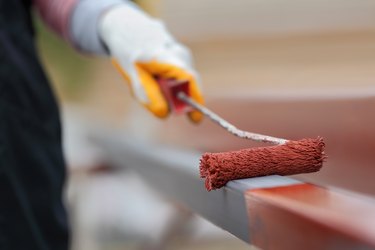
Someone else's trash could easily become your treasure with a little TLC. Giving new life to painted metal furniture and other metal objects does require some physical labor, and skipping any steps will probably result in a messy-looking finished product. Painting over painted metal is one of those jobs that anyone with a little patience can master. The end result is totally worth the effort because a neat repainting job can last for many years.
Assessing Painted Metal Items
Video of the Day
Before you're ready to start painting over painted metal, it's important to inspect every inch of what you're planning to paint. The current condition of the painted metal item is important because it affects what kind of preparation will be required before you can add a new coat of paint. Examine it all over, looking for any cracks or rust spots. If there are any areas that you want to remain untouched by new paint, cover them with painter's tape.
Video of the Day
While you're doing this, think about what kind of paint will be appropriate for the task. Does it have mostly smooth surfaces? Using a brush to paint should work fine. If it has a lot of crevices and detailing, spray paint will be more effective at getting into all the nooks and crannies.
The last thing to do before getting started is to set up a safe painting environment. Choose a well-ventilated area in which to work where painted metal can be allowed to dry overnight. Lay down drop cloths and gather a dust mask and protective glasses to wear while you work.
Prepping Painted Metal for Repainting
If your painted metal items have any rust spots, removing those is the first task. Use a stiff wire brush and plenty of elbow grease to remove as much of the surface rust as possible. It's possible to paint over rust, so it's OK if some is still visible – just try to remove as much as you can.
If the item has any cracks or holes that need repairing, sand those areas to reach bare metal. Use an epoxy made for metal to fill in the holes. Make sure it dries completely before moving on to the next step.
Even if the item's current paint is in great condition, it's advisable to sand the entire thing before painting. Roughing up the surface will help the next coat of paint stick. Use fine-grit sandpaper to lightly sand the entire area you plan to paint either by hand or using a power sander. Next, pour mineral spirits on a clean rag and wipe the surface to remove any lingering grit or dust.
Painting Over Painted Metal
Finally, you're ready to apply paint. Start with a layer of primer made especially for use on metal, which will help the new paint bond to the surface. Coat the entire item and let it dry according to package directions. It may take as little as 15 minutes or as long as 24 hours for a coat of metal primer to dry depending on the manufacturer. (If you're going to paint over visible rust, be sure to choose a rust converter primer.)
The last step is the actual painting. It's important to only use paint that's designed for use on metal. They come in both oil- and water-based formulas, though oil-based metal paints tend to be more common. They're also more durable than water-based paints, so choose oil if you're painting anything that will be left outdoors.
Water-based paints may be easily scuffed and marked. On the other hand, they dry quicker and have less-intense fumes than oil-based paints. This choice is a matter of personal preference.